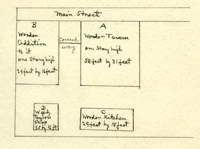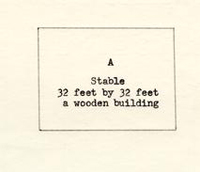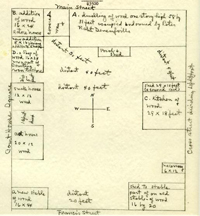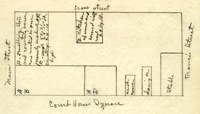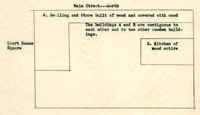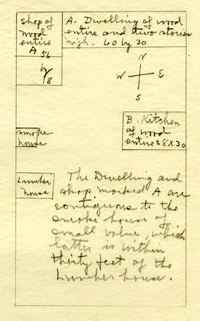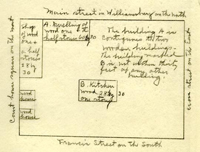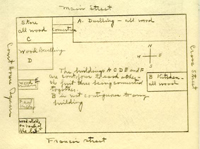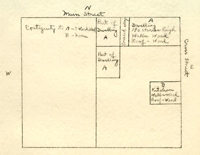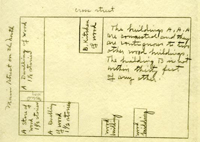Market Square Tavern Historical Report, Block 12 Building 13 Lot 12Originally entitled: "Market Square Tavern Block 12 Lot 12"
1955
Colonial Williamsburg Foundation Library Research Report Series - 1252
Colonial Williamsburg Foundation Library
Williamsburg, Virginia
1990
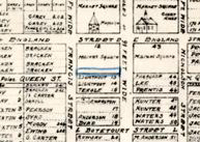 PHOTOSTAY COPY OF THE
PHOTOSTAY COPY OF THE
WILLIAMSBURG PLAT IN "WILLIAMSBURG.
THE OLD COLONIAL CAPITOL" BY LYON G. TYLER
MARKET SQUARE TAVERN
Block 12 Lot 12
LOCATION:
Colonial Lot 12 lies on the south side of the Market Square. It is not numbered on early plats of Williamsburg as it was a part of the Market Square.
HISTORY: (In Summary)
This colonial lot was a part of the Market Square. It was leased for a period of 21 years to Dr. John Dixon in 1749. From this date to 1930 the property passed from one lessee to another. Dr. Dixon increased the size of the lease to him in 1751 by a breadth of ten feet. Dixon may have erected a "new store" on the land, for when he wished to sell all of his property in Virginia, he noted "a new Store adjoining the Market Place in Williamsburg, subject to Ground Rent." John Hood, a merchant from Prince George County, took over Dixon's lease until 1757 when James Johnson, another Prince George County merchant, became the lessee. In 1760 Robert Lyon, a barber, tavernkeeper and merchant, secured the lease via Johnson. Lyon may have been renting the storehouse from Johnson prior to his acquiring the lease. A list of goods he offered for sale appeared in the Virginia Gazette of 1759. Thomas Craig, a tailor, became a tavernkeeper on this property when he secured the lease via Lyon in 1761. Craig may have made changes in what houses were standing. At any rate, when he advertised the place for sale in 1770 he noted there was "a dwellinghouse, fine cellars, stable large enough for 30 horses, large fodder loft, kitchen, large smoke house and added room, good shop, lodging rooms and a store." In 1771 Gabriel Maupin, harnessmaker, had gained possession of the lease or ground rent, having bought the house at a public sale of Craig's possessions. Maupin announced that he was making "considerable Additions and Improvements,for the Purpose of Keeping Tavern..." and that his shop where the Saddlery and Harness Making Business is carried on will be moved to this location. His tavern was large enough, apparently, to serve dinners to the Botetourt Lodge of Masons (who also planned to have a ball there), to rent some rooms to the Lodge for several years, to allow lecturers to entertain there, to board travellers and their servants and to make saddles, harness &c. in the shop on the lot. By 1792 Maupin had a Williamsburg carpenter whitewash 13 rooms upstairs, and a long passage; and in 1793 repairs were made to 4 rooms, 2 closets, 3 rooms, 1 passage and a stairway. In 1796 Maupin insured the property stating that there was a dwelling-house, addition, kitchen, shop and &. The dimensions indicate that it was a house 58 feet x 31 feet, with an addition 24 feet x 16 feet. The Frenchman's Map of Williamsburg (1782) shows a large house flush to the street (facing south) with several outhouses to the rear. By 1809 Peter Robert Deneufville had taken over the lease. His insurance policy shows a "dwelling, addition, new addition, shop and counting room, kitchen, new stable, old stable, smoke house and ash house." According to excavations made in 1931, they were practically identical to the dimensions of Deneufville's houses on the property in 1809. While Deneufville was owner there were seven additional insurance policies on the property running through 1860. The general set-up of the dwelling and outhouses remain the same. In the later part of the nineteenth century the property fell under lease to Deneufville's brother, his daughter, and then in 1887 it became the property of James E. Banks. Banks' heirs conveyed the property under lease to Williamsburg Holding Corporation. It is now the property of Colonial Williamsburg, Incorporated, and has been restored.
| DATE | OWNER | LOCATION | RESIDENT | ARCH. CHANGES | TRADE |
| 1749 | John Dixon (21 yr. lease) | "south side of Market Place" | Merchant | ||
| 1751 | John Dixon (lease) | "south side of Market Place" | "new store" | Merchant | |
| 1751 | John Hood (lease) | "south side of Market Place" | Merchant | ||
| 1757 | James Johnson (lease) | "ss of Market Place" | Merchant | ||
| 1760 | Robt. Lyon (lease) | "ss of Market Place" | Lyon | Barber, Lodgings, Merchant | |
| 1761 | Thomas Craig (lease) | "south side of Market Place" | Craig | houses | Lodgings, Tailor, Tavern (176 Tavern-keeper & Tailor |
| 1770 | Thomas Craig (lease) | "centre of city" | Craig | tavern, shop, stables, cellars, kitchen, store, &c. | |
| 1771 | Gabriel Maupin (lease) | "Market Square House & Shop" | 1774-Masons rented 1777-9 Do 1786-Boarded Students | "considerable additions & improvements" | Tavern-keeper Saddler |
| 1792-3 | Gabriel Maupin | repairs to 13 rooms, stairs, passages &c | |||
| 1796 | Gabriel Maupin | "Main Street" | James Moore | addition to the tavern, tailor's shop &c. | |
| 1808 | Peter R. Deneufville (lease) | "East Court House Square" | P. R. Deneufville | Dwelling, new addition, new stables &c. counting room | Merchant |
| 1813 | Peter R. Deneufville | Mrs. Tyler | |||
| 1815 | Peter R. Deneufville | John Coke | Tavern-keeper | ||
| 1823 | Peter R. Deneufville | "leased land" | Mrs. Coke | ||
| 1830 | Peter R. Deneufville | James J. Sanford | |||
| 1839 | Peter R. Deneufville Est | Mrs. Lucas & others | |||
| 1846 | Peter R. Deneufville Est. | Thomas Jones | Merchant & Constabl | ||
| 1853 | P. R. Deneufville Est. | Philip J. Barziza | |||
| 1860 | John A. Deneufville's Est | A. Lytle & others | |||
| 1874 | Marion D. Barlow (lease) | ||||
| 1887 | James E. Banks (lease) | ||||
| 1917 | Banks' heirs (lease) | ||||
| 1929 | Williamsburg Holding Corporation | ||||
MARKET SQUARE TAVERN
Block 12 Lot 12
LOCATION:
Colonial lot 12 lies on the south side of Duke of Gloucester Street in Williamsburg, with the Market Square bordering it on the west. See: Tyler's adaptation of late eighteenth century and early nineteenth century maps on opposite page.
HISTORY:
The property has been under a lease from the trustees of Williamsburg from 1749 until 1930. From 1749 to 1782 the lease is noted repeatedly in deeds of conveyance; from 1782 to 1930 the lease is noted in land tax records, chancery suits and deeds. Most Williamsburg lots were conveyed outright in fee simple (after building clauses had been complied with). Being a part of the Market Square area must be the explanation for the leases and renewals throughout the years. The city was not willing to sell outright its property adjoining the public greens.
The first lessee—so far as research has been able to find—was Dr. John Dixon.1 An original document now owned by Colonial Williamsburg gives this information:
July 3d 1749.On The application of Doctr John Dixon a Lease is granted him for 21. years of a piece of ground in The Marketplace, on The South Side The Main Street, opposite To and of The Same dimensions With That granted The Honble John Blair and now in The Occupation of Thos Bennett and for The Rent of 30s. per-Annum: with usual Conditions.2
(Dr. Blair's lease was on the opposite side of Duke of Gloucester Street. See: House History of Chowning's Tavern, Research Department.)
On February 9, 1750 (about six months after the first lease), Dr. Dixon increased his land by taking in land towards the west:
2 Feby 9th 1750.On The application of Doctr John Dixon a Lease is granted him for 21. years of apiece of ground in The Marketplace adjoining To The West side of That formerly leased To him and To Extend 10. feet beyond The ground leased To Math. Moody: Thence South To Francis Street, Thence Easterly to intersect The Fast line of his former grant and That The whole Yearly Rent for This and The former grant be five pounds—With a Covenant for renewing The lease upon paying a fine of 3 years Rent provided The Same is Sued out at least 3 years before This lease Expires and With alike Covenant for Renewing from Time To Time for ever.1
John Dixon seems to have been a doctor and a merchant. In April, 1751, he announced in the Virginia Gazette that he had come from England in 1749,2 and in May, 1752, he signs himself as "merchant " in Williamsburg.3
In September, 1751, the Virginia Gazette carried a long notice from Dixon in which he announces his intention to return to England in the spring. He wishes to dispose of all of his property—both real and personal—in Virginia. Among the property for sale was: "a new Store adjoining the Market Place in Williamsburg, subject to Ground Rent."
[September 19, 1751]THE Subscriber, intending for England in the Spring, with his Family; is willing to dispose of several valuable House Servants, and Tradesmen, viz. Blacksmiths, Shoemakers, Carpenters, Barbers, and Plaisterers, a neat Chariot with front and side Glasses, Six Horses and Harness, all Manner of Household Goods, Plate, China, &c. Also the following Lands, viz.
Two Lots in the Town of Newcastle, with a Warehouse thereon. About Three Hundred Acres, within Four Miles of Newcastle, well wooded.
One Thousand and Forty Acres on Chicahominy, with a very good Brick House, 60 by 20, in good Repair, a large Brick Dairy, and other necessary Buildings. The Plantation is ready for cropping, with Ten Hands. To be dispos'd of with or without the Stock.
Also a new Store adjoining the Market Place in Williamsburg, subject to Ground Rent.
Any Person inclining to purchase may know the Terms of Sale by applying to me, in Williamsburg. John Dixon.4 3
From this notice we can see that Dixon may have built a "new store" immediately upon receiving his lease from the trustees. "New store" implies that there had been an old store previously.
On November 18, 1751, Dixon sold and conveyed unto John Hood,1 merchant, the residue of his 21 year lease.2 Hood held the property until May, 1755, when he put it into the hands of trustees who sold it in January, 1757, to James Johnson.3
On May 3, 1760, James Johnson, merchant, conveyed the property to Robert Lyon, merchant:
[May 3, 1760]
[James Johnson, merchant of Prince George County, Virginia, to Robert Lyon,4 merchant of Williamsburg,
Consideration: 150 pounds current money of Virginia]...Hath Granted Bargained Sold and Assigned...All that Parcel of Ground Situate in the Market Place of the said City on the South Side of the Main Street which was Conveyed by the Feoffees or Trustees of the said city to John Dixon by a Deed of Lease bearing date the fifth day of February seventeen hundred and forty nine for the term of 21 years reserving the yearly rent of five Pounds during the said Term and by the said John Dixon was Sold and Conveyed unto John Hood Merchant by Indenture bearing date the eighteenth day of November seventeen hundred and fifty one for the residue of the said Term and by the said John Hood the residue of the said Term was by Indenture of Lease and Release bearing
4
date the second and third days of May seventeen hundred and fifty five among other things Conveyed unto Hugh Miller James Graham John Peters Robert Jones and James Power Gents. in Trust for the Purpose therein mentioned and by the said John Hood and his said Trustees the residue of the Term aforesaid was by Indenture bearing date the third of January seventeen hundred and fifty seven conveyed unto the said James Johnson as by the said Indentures recorded in the General Court of this Colony relation being thereunto had may appear and all houses Out houses Buildings Yards Gardens...belonging...TO HAVE AND TO HOLD the said Parcel of Ground with the Appurtenances unto the said Robert Lyon his Executors Administrators and Assigns from hence forth for and during all the rest and residue of the said Term of twenty one Years Yet to Come and unexpired...IN WITNESS whereof the Parties to these Presents have hereunto Set their hand and Affixed their Seals the day and Year first above written.
Sealed and Delivered
In Presence of
John Bell
James Martin
Peter Powell
James Johnson (L.S.)1 [Recorded York County Court June 16, 1760]
As Hood, Johnson and Lyon were designated as "merchants" it is assumed that they occupied the "new store" erected by Dixon at the Market Square.2 As the consideration named was 150 pounds, it looks as though Hood or Johnson may have enlarged the buildings on the lot after Dixon sold out his lease.
In 1759 (November), Lyon must have been at the location of James Johnson. He could have been there for several years as we do not know when he left "Edinburgh Castle" [Lot 58].3 If so, these were his wares:
[November 30, 1759-]Just IMPORTED, and to be SOLD reasonably, by the Subscriber, at his STORE, in the MARKET-PLACE, Williamsburg, A CHOICE Assortment of Goods suitable for the Season,
viz.—Cloths, Duffles, Bearskins and Frizes, with Trimmings; Scots and 5 Irish Linens, Sheeting, coarse and fine Checks, striped and checkt Hollands, Chintzes, Calicoes, printed Linens, checkt and printed Handkerchiefs, both coarse and fine; Cambricks, Lawns, Ruffles, Borders, &c. best stitched and bound Shoes and Pumps, plain Shoes and Pumps, Womens Calimanco Shoes and Pumps, Men and Womens Gloves, best Nuns Thread, an Assortment of Stuffs for Womens Gowns, &c. a large Assortment of Copper, Pewter and Tin, Wares; Delph and Stone Wares; a large Variety of Cutlery, well sorted, and of the best Kind; Cabinet-Makers, Joiners and Shoe-Makers, Tools and Materials; with a great Variety of other Goods,—Also Sugar, Coffee, Rum and Molasses, Robert Lyon.1
Lyon did not hold the lease but a short time. On November 10, 1761, he conveyed to Thomas Craig, tailor of Williamsburg:
[November 10, 1761][Robert Lyon of Williamsburg to Thomas Craig, tailor of Williamsburg, Consideration: 350 pounds current money of Virginia]
...Hath granted Bargained Sold and Assigned...unto Thomas Craig his Executors Adminors...All that parcel of Ground Situate in the Market place of the said City on the South side of the Main Street which was conveyed by the feoffees or Trustees of the said City to John Dixon by a Deed of Lease bearing date the fifth day of Feb[torn] one thousand seven hundred and forty nine for the Term of twenty one Years reserving the yearly rent of five pounds during the said Term and by the said John Dixon was sold and Conveyed unto John [torn] by Indenture bearing date the eighteenth day of November seventeen hundred and fifty one for the Residue of the said Term and by the said John Hood the residue of the sd Term was by Indenture of Lease and Release bearing date the second and third daies of May seventeen hundred fifty five among other things Conveyed unto Hugh Miller James Graham John Peters Robert Jones and James Power Gents. In Trust for the purpose therein mentioned and by the said John Hood and his said Trustees the residue of the sd Term aforesaid was by Indenture bearing date the third day of January seventeen hundred fifty seven Conveyed to the said James Johnson and by the said James Johnson all the rest and residue of the said Term was Sold and Conveyed unto the said Robert Lyon by Indenture bearing date the third day of May seventeen hundred sixty...the four first mentioned of which are recorded in the General Court of this Colony and the other in the County Court of York relation being thereunto had at large Will appear, And all Houses out houses buildings Yards Gardens...To have and to hold the said parcel of Ground with the Appurts unto the said Thomas Craig his Exors Admors and Assigns from henceforth for and during all the rest and residue of the said Term of Twenty one Years Yet 6 to come and unexpired...IN WITNESS whereof these said Parties have hereunto set their Hands and Seals the day and year first Above Written.
Sealed and delivered
In presence of
Edward Charlton
Gabriel Maupin
Jas Martin
Robt Lyon (L.S.)
Received of Thomas Craig the Sum of three hundred and fifty pounds being the Consideration for the Land within mentioned.
Received by me Robt Lyon
Novr 1761. At a Court held for York County the 16th day of November 1761 [this deed was ordered to be recorded].1
Within one year the consideration asked changed from 150£ to 350£.
Prior to Craig's acquisition of the Market Square property he was living in the city as a tailor.* He had married Anne Pasteur, sister of Dr. William Pasteur, and according to the parish register, had a son, Thomas, baptized in 1759 at Bruton.2
In 1763 Craig gave notice in the Virginia Gazette that he would welcome payments due him on accounts.3 These notices were repeated in 1766, 1767, and 1768.4 No location was given in these notices.
In February, 1767, Craig notified the public that he had taken out a license for a "publick-house" 5 and also that he would continue to carry on "my business" [tailor]:
WILLIAMSBURG, Feb. 12, 1767,
I TAKE take [sic.] this OPPORTUNITY of informing the Gentlemen, who used to lodge at my house in publick times, that their rooms will be still kept for them; and that I have taken out a license for publick-house keeping, furnished myself with good liquors, &c and shall be glad of their future favours. Notwithstanding, I shall still carry on my business; and hope to have
7
it in my power to give satisfaction to my former customers, as well as to all who may please to employ me.
THOMAS CRAIG, Tailor.1
From this notice we see that Craig had had a rooming house prior to this date, when by license, he became a tavern keeper. Things went on in this way until August, 1770, when Craig advertised his real estate and personal property for sale at public auction:
To be SOLD at PUBLICK AUCTION, on MONDAY the10th of SEPTEMBER, on the premisses,THE dwelling-house at present occupied by the subscriber, which is very well calculated for publick business, being in the centre of the city, and every convenience to it for a tavern. There are fine cellars, an exceeding good stable for thirty horses, with a large fodder loft, a very good kitchen, with a room adjoining, a large and strong smoke-house, at one end of it a place for people to sleep in, an excellent well of water, and a good garden. There is likewise a very good shop, on the main street, which might be converted into three or four lodging rooms; and there is a cellar under it. The house might be made much larger, at a very trifling expense, by taking in a store, at one end of it, which rents for 20£ a year. Upon paying 100£ in October next, the purchaser will have two years credit for the remainder.
At the same time will be sold sundry household and kitchen furniture, particularly a number of very good beds and bedding; on credit, until April, for all sums above 5£ the purchasers giving bond and security.
The above sale being made in consequence of my resolution immediately to discontinue tavern keeping, and to have my affairs settled, I desire every person who is indebted to me to make payment in October ensuing, as after that time, all accounts due to me a lawyer will have the collecting of. THOMAS CRAIG.2
WILLIAMSBURG, August 30, 1770.
Note details such as large stable, cellars, kitchen, extra rooms, shop, lodging rooms, etc.
The sale evidently did not take place on schedule. On June 27, 1771, Henry Dixon, trustee for Craig's creditors, advertised that the house and lot and all household and kitchen furniture would be sold in July:
WILLIAMSBURG, June 27, 1771.
ON Thursday the 18th of next Month will be sold to the highest Bidder, upon Credit till the 30th of October 1772, the HOUSE and
8
LOT whereon Mr. THOMAS CRAIG now lives. Bond and good Security, bearing Interest from the 20th of August next, will be required, at which Time the Premisses will be delivered up.—And on Monday the 12th of August will be sold upon six Months Credit for all Sums above twenty Shillings, all his HOUSEHOLD and KITCHEN FURNITURE, and five LOTS of GROUND in Bell-Craig Street. Bond and Security will be required.
HENRY DIXON, Trustee for the Creditors.1
Gabriel Maupin2 was the purchaser.3 He announced in September, 1771, that he was the owner:
WILLIAMSBURG, September 26, 1771.AS I HAVE PURCHASED THE HOUSE IN THE MARKET Square lately occupied by Mr. Thomas Craig, to which I am making considerable Additions and Improvements, for the Purpose of KEEPING TAVERN, this is to acquaint my Friends, and the Publick in General, that the House will be ready for their Reception by the Beginning of the ensuing General Court, where they may depend upon Meeting with the best Entertainment and Accommodations from
Their humble Servant, GABRIEL MAUPIN.
:.My shop will likewise be moved to the Above Place, where the SADDLERY and HARNESS MAKING Business will be carried on in all its Branches. Those who please to employ me may be assured of being furnished with neat and substantial Work, at short Notice, and on reasonable Terms.4
Maupin patronized Edward Charlton, Williamsburg wigmaker and barber, from 1769-1776. Maupin is charged with "shaving and dressing [yearly], curls for Mrs. Maupin, dress bob wigs, 2 dozen clarritt &c."5
Maupin was long an active and influential member of the Botetourt Chapter of Free Masons in Williamsburg. In the Ms Treasurer's Book of this Chapter are items which would seem to indicate that the Lodge Rooms may have been located at Maupin's house for several years. Other items 9 note that the Masons had entertainments, funerals, etc. for members at Mr. Maupin's:
1774, June 25—"By pd G. Maupin in part for Rent £10.10.- 1774 Feast of John the BaptistOrdered That the Treasurer pay unto Brother Maupin the Sum of Twenty pounds for the use of the Lodge the last year.
1775 June 16—The occasion of the meeting being open to the Lodge the Right Worshipful Master Viz. to attend the Remains of our deceased Brother John Turner, they accordingly repaired to the House of Brother Gabriel Maupin, where the Corps lay, and having accompanied the same to the Church and performed the Funeral obsequies in due form returned to the Lodge.
1776, Dec. 17—The Ball called off on account of the critical times and that tickets be issued to all regular made Masons at 12 and 6 pence each for the Dinner on St. John's Day, to be prepared by Brother Maupin.
1777, June 17—By Cash paid Gabriel Maupin for the rent of the Lodge, from May 29th 1774 to June 24th, 1777.
1779, April 10—Funeral of Brother Williamson went from the house of Brother Maupin where the Corpse lay . . . Returned to the Lodge in due order and dispersed."1
Several interesting items are given below to indicate something of Maupin's life and interests during this period:
1769-1774 Maupin is charged by Edward Charlton, Williamsburg barber and wigmaker, with curls for Mrs. Maupin, dress bob wigs, year's shaving and dressing and 2 dozen bottles claret.21775 "Mr. Wall to deliver at Mr. Gabriel Maupin's . . . a LECTURE on ELECTRICITY."31776 Maupin's bill to Patrick Henry for saddles, harness &c. £19.11.04
The Frenchman's Map of Williamsburg (1782) shows a large house flush to the street with several outbuildings to the south.5
In 1782 Maupin is indicated in the Williamsburg Land Tax as having "1 lot valued at 5 pounds."6
10In 1783 personal property taxes for the city show Gabriel Maupin as owner of "19 slaves, 5 horses and 1 cattle."1 Maupin took out ordinary licenses from 1786 to 1800.2
In 1786 Maupin was still running his tavern. Mann Page boarded with him:
| "For Board from Feby 19th till 30th Octr 1786 at £35 p ann | £24.6.8 |
| Do for you Servants Board for the same time ...£12 p Ann 1786 | 8.6.8 |
| Novr 12th Ball of your Open Acct till this day | 2.11.8 1/2 |
| £35.5.1/23
^
3. Original Ms in Research Department Archives.
|
In 1788 a memorandum of accounts of Humphrey Harwood unsettled at his death (on November 23, 1788), listed Gabriel Maupin as owing £133.18. 1 1/2.4
In 1796 Maupin's property was insured with the Mutual Assurance Society thus: "My Two Buildings on the Main Street in Williamsburg now occupied by James Moore5 situated between the cross Street and that of Wm Lightfoot in the county of James City...The Tavern at $850, The Addition at $120, The Kitchen at $120 and The Shop at $100. Wooden tavern 58 by 31 feet one story bldg; wooden addition 24 by 16 feet ; wooden kitchen 29 x 18 feet and a tailor's shop 25 x 15 feet."6
11In 1792-1793 Maupin had repairs made to the property by Humphrey Harwood, Williamsburg carpenter and brick mason. Such changes as mending plastering, whitewashing 13 rooms up stairs and a long passage, taking down and setting up a grate was done by Harwood.1
Maupin took out an ordinary license according to the personal property tax list from 1786-1800. From 1794-1797 he listed a billiard table and a stud horse.
By 1801 Maupin had died. His heirs in 1808, conveyed to Peter Robert Deneufville "...a House and lot in this City, which the Said Gabriel Maupin held under Lease for Twenty one Years renewable forever, from The Corporation of This Said City; wishing Therefore The Said Deneufville, his heirs, Exors or Admors To Receive from The Trustees or feofees of The Said Corporation a proper Title for The Time Remaining of The present Lease Which is to expire 9th July 1813. and also...having Transfered To him all The Right and Title Which The Said Gabriel Maupin decd had Therein:—Williamsburg 15th Feby 1808.2 (Such conveyance was begun in 1807.)
In 1809 Deneufville insured the property thus: "...that they are now occupied by Peter Robert Deneufville and that they are situated south of the main street in Williamsburg, east by the Courthouse square north by Francis Street and West of a cross street dividing Lightfoot's lot...The Dwelling house at $2000; the store house at $500; the kitchen at $500 and the counting house at $500."3 A "new addition" had been built between the "addition" and the shop. A part of the shop was used as a counting room to the store. An ash house and a "new stable" had been erected also.
12In 1813 a "Mrs Tyler had moved to the house formerly occupied by Peter R. Deneufville and rented her house to Doctor Tazewell."1
In 1827 there must have been a fire of some consequence at the property. A letter from Robert Saunders, Williamsburg, to Joseph Prentis, Suffolk, refers to the fire in this way: "The fire which the Beacon, spoke of, was of small consideration at the College—a spark from a Chimney caught the shingles about mid-day, but was extinguished in ten minutes—The fire which consumed part of poor old Deneufville's tenement was an alarming one, as the Church was, for a time, in danger."2 We interpret "the Church" as the Baptist Church which was using the Public Magazine (about this period) until a church could be built. It could not have been Bruton Church as that was more than a block away.
Deneufville was arraigned by the Grand Jury of Williamsburg in 1837 for selling spirituous liquors without certificate and for unlawful assembleges of negroes on his premises to the disturbance of the neighbors.3
Deneufville insured his property in 1815, 1823, 1830, 1839, 1846, 1853, and 1860. He evidently made no repairs from 1809 (when the property was valued at $3500) until 1815 (when the valuation was given at $2200). In 1815 the dwelling, addition, new addition, shop and counting house had been united into one building. The old stable had disappeared or was not insured. In 1823 the dwelling, store and kitchen were valued at $2834. In 1830 the dwelling entire was two stories high 60 x 30 feet with shop 13 attached to the west 56 x 18 feet, and a lumber house also noted. In 1839 the dwelling was 60 x 30 feet with shop attached 28 x 30 feet, kitchen 28 x 30 feet. In 1846 no dimensions were given to any of the buildings. A note stated that the buildings A C D E & F are contiguous to each other—the first three being connected together. B is not contiguous to any building. In 1853 no dimensions are given but buildings A A A are connected and contiguous to two other buildings. B is not contiguous within 30 feet of any building.1
As to occupants of the property from 1815 through 1860: Insurance policy #1767 (1815) states that John Coke was occupying the property.2 Coke, evidently, occupied it until his death; and following, Mrs. Coke remained thereon.3 In 1830 policy #7586 notes that the property was then occupied by James J. Sanford.4 In 1839 a Mrs. Lucas and other tenants were tenants.5 In 1846 Thomas Jones was renter. Jones was there in 1847: "Thomas Jones of Williamsburg, residing in that part of said City which is in James City Co (house belonging to Deneufville Est) was appointed crier of the Court, under the Act of 1833—Also Constable for that portion of York County lying above King's Creek..."6 In 1853 Philip J. Barziza was living on this location as a renter from the Deneufville 14 estate.1 In 1860 A. Lytle was occupant.2 One of Barziza's children was Miss Philipa Barziza. An article in the Virginia Gazette of September 15, 1853 entitled, "Education in Williamsburg," called attention "to the school of Miss Philipa Barziza teaching French, Latin, higher English and piano." It is quite probable that Miss Barziza's school was operated in her father's home.3
A glance at the Williamsburg Land Tax records for this property will show that the lot was still owned by the Corporation of Williamsburg and leased to Maupin and then, to Deneufville until 1861 when these records cease.4
Only two land tax records seem to have survived the Civil War period and up to 1870. The Williamsburg Land Books for 1865 and 1870 disclose that Peter Robert Deneufville's estate held a lot valued at $2000 which was a lease from the corporation and exempt from city tax.5
A study of the abstract of title made in 1929 for Williamsburg Holding Corporation states that the property came into the possession of John A. Deneufville who died in 1874 devising his whole estate to his wife, Harriet, during her natural life; and at her death to John H. Barlow, Jr. in trust for the sole use of his daughter, Marion Barlow, then the wife of John H. Barlow.6
15"In 1886 the Mutual Assurance Society instituted a suit against Marion D. Barlow to sell the interest of said Marion Barlow in certain property situate in the City of Williamsburg on which the said Marion Barlow had a lease from the City for 21 years, renewable forever for the purpose of paying certain debts due the Mutual Assurance Society. The Commissioner filed his report...The aggregate of rent (ground rent) for this house and lot from 1873 to January 1887 inclusive making 15 years at $10 per annum $150. ...The said Marion D. Barlow as the owner of the said buildings and lot is now indebted under the authority of the Constitution, rules and regulations of the said Society, in the sum of $251.87, for the quotas assessed for the years 1874, 1875, 1876, 1877, 1878, 1879, 1880, 1881, 1882, 1883, 1884, 1885, 1886, with interest..."1
In December 1886 a public auction before the front door of the Courthouse as by decree, resulted in the property being sold to James E. Banks at the price of $500.2 However, a deed was not delivered to the property until 1891 due to the fact that all the purchase money had not been paid and to the lease condition about the lot on which the houses stood. In 1891 the property was described thus: "doth grant unto the said James A. Banks with Special Warranty the lot of land with the buildings thereon situate in the City of Williamsburg and bounded as follows on the north by Main St. on the west by the Court house square, on the south by Francis Street, and on the east by the cross street...."3 Several deeds of trust followed and a deed of correction and declaration stated that confusion has arisen because Barlow had only the right "to convey the lease 16 hold interest in the lot, the same being for the term of twenty-one years, with privilege of renewal forever upon condition fully understood by all parties, and the improvements which have been placed on the said lot by the said Marion D. Barlow and her Devisor."1
Banks died between April and August, 1916.2
Heirs of Banks (Rado L. Banks, Alva B. Banks and others) conveyed to Williamsburg Holding Corporation with general warranty the usual covenants of title thus:
...All that certain lot or parcel of land situated in the City of Williamsburg, Virginia, together with the buildings and improvements thereon, the said lot lying on the south side of Duke of Gloucester Street, and bounded and described as follows: Beginning at the southwest intersection of Duke of Gloucester Street and Queen Street, and thence extending west along the south side of Duke of Gloucester Street to the lot now occupied by the A. and P. Store, the fee in which lot is in the City of Williamsburg, and the leasehold whereof was conveyed by Marion A. Stone to William A. R. Goodwin; thence from said point along said lot of Marion A. Stone and along the old colored school lot, more recently conveyed by Lelia A. Durfey to William A. R. Goodwin, out to Francis Street; thence east along the north side of Francis Street to Queen Street; thence north along the west side of Queen Street to the point of beginning. Being the same lot of land conveyed to James A. Banks by deed from B. D. Peachy, Special Commissioner [in a deed of correction]...dated April 14, 1916, and recorded in Williamsburg Deed Book No. 7, pp. 263-264. The lot hereby conveyed is bounded on the north by Duke of Gloucester Street; on the east by Queen Street; on the south by Francis Street; and on the west by what was formerly called Court House Square.3Mr. John S. Charles, an old citizen of Williamsburg, writing in 1933 of the city as he recalled it during the Civil War period, had this description of the property:
Where the Raleigh Hotel now stands, there was an old, very old frame building, which was used before the War as a dwelling, and after the War as a hotel. The present hostelry was built not many 17 years ago, and much of the material in the old house was used in the present structure.The old house was built on brick work, about six feet above the street, with a single porch and steps up to it. The house next to it, on the west, was very like the one now occupied by Dana and Spencer as a real estate office. This building was a single story and the first floor was about three feet from the ground and once used as a store, soon after the War, the Post Office was in this house. To the rear, and joined to it, was a story and a half building with dormer windows and door upon the west side. On the rear of this lot on Francis Street there was a wooden barn and a stable.1
Mrs. Victoria M. Lee, another old citizen of Williamsburg, gave her impressions of the city in 1861. Her recollection of the Market Square property was thus:
Where now stands the restored Market Square Tavern, stood a long, frame story and a half building very much like it. This building was the home of Dr. Charles Waller. Connected to this long building was a tiny store, end to the street, and entrance to the west side of the house. Mrs. Hazelgrove kept a candy shop in this part of the building.2Mr. Banks, son of James E. Banks, owner of the property from 1887-1916, stated to Mr. Harold R. Shurtleff and Mr. Rutherfoord Goodwin in 1930 that "he remembers it [the house] as a story and a half gabled building with a simple pitched roof with four dormers, equally spaced. He believes that the present openings on the first floor are the same as they were at the time it was a story and a half house."3
Charles Brown, a negro who was born in 1850, was a slave in the Galt family who was living at Grove in 1930 was interviewed. Brown "remembers it [the building] as a story and a half house with a "V-shaped roof" as he described it, and eight or ten dormers and four chimneys along the Duke 18 of Gloucester Street side. The L which extended back toward the south had long, narrow windows with twelve panes in the first floor, but no dormers on the L roof facing west. This L had a chimney at the gable end but the chimney was covered with the weatherboarding of the gable end. Brown does not remember whether the L was extended from the extreme east end of the house or whether it sat back enough to make the plan a T shaped one."1
The Archaeological Report (1931, Ragland) states that "Although most of the recent Raleigh Hotel is modern, parts of it are very old. Walls 4, 5, 6 & 7 and the remains of basement steps 8 are bonded together and are undoubtedly the foundations of the oldest part of the building, what was the original colonial house (A), for the brickwork is colonial in bond, mortar, brick size and color, and the timbers above are hand hewn and framed for a complete house." Mr. Ragland believes that Maupin actually enlarged the building. He thinks the house covered the present area by 1809, for the dimensions of the complete foundation 57' 2 1/2" x 31' 3 1/2" practically agree with the measurements 58 x 31 feet as given in the policy of 1809.2
Illustration #1
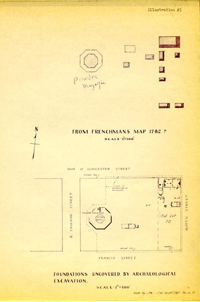 FROM FRENCHMANS MAP 1782?
FROM FRENCHMANS MAP 1782?
SCALE-1"=100'
 FOUNDATIONS UNCOVERED BY ARCHAEOLOGICAL EXCAVATION.
FOUNDATIONS UNCOVERED BY ARCHAEOLOGICAL EXCAVATION.
SCALE-1"=100'
Illustration #2
| 1782 | Gabriel Maupin | 1 lot | £ 5 |
| 1786 | Gabriel Maupin | 1 lot | 7.10 |
| 1788 | Gabriel Maupin | 1 lot | 25.-.- |
| 1789 | Gabriel Maupin | 1 lot | 16.10 |
| 1792 | Gabriel Maupin | 1 lot | 17.- |
| 1797 | Gabriel Maupin | 1 lot | 30.- |
| 1798 | Gabriel Maupin | 1 lot | $100 |
| 1799 | Gabriel Maupin | 1 lot | $100 |
| 1801 | Gabriel Maupin | 1 lot | $ 70 |
| 1806 | Gabriel Maupin est. | 1 lot | $ 70 |
| 1807 | R. Peter Deneufville | 1 1/2 lots | $100 |
| 1809 | R. Peter Deneufville | 2 1/2 lots | $200 |
| 1817 | Peter R. Deneufville | 3 1/4 lots | $140 |
| 1819 | P. R. Deneufville est. | 3 1/4 lots | $310 |
| 1820 | P. R. Deneufville est. | 1 lot & bldgs | of the Corporation |
| 1822 | P. R. Deneufville estate | 1 lot & bldgs | $2000 The ground on which the house stands belongs to the Corporation |
| 1830 | P. R. Deneufville est Lease | 1 lot & bldgs | $2000 The ground belongs to the Corporation of Williamsburg |
| 1835 | P. R. Deneufville Est Lease | 1 lot | $2000; L & B-$1800 The ground belongs to the Corporation of Williamsburg |
| 1840 | P. R. Deneufville Est Lease | 1 lot | The ground belongs to the Corporation |
| 1843 | P. R. Deneufville Est | 1 lot | $2000 The ground belongs to the Corporation of Williamsburg |
| 1851 | P. R. Deneufville Est Lease | 1 lot & b | $1800 [no comments] |
| 1853 | P. R. Deneufville Est Lease | 1 lot & b | $1800 Corporation Ground |
| 1858 | P. R. Deneufville est Lease | 1 lot & b | $2000 [no comments] |
| 1859 | P. R. Deneufville Est Lease | 1 lot & b | $2000 Corporation Ground |
| 1860 | P. R. Deneufville est Lease | 1 lot & b | $2000 Exempt from Corporation Tax on acct. of Lease |
| 1861 | P. R. Deneufville est | 1 lot & b | $2000 Exempt from Corporation Tax on acct. of Lease. |
| [Williamsburg Land Tax records end with 1861.] | |||
| Williamsburg Land Books for 1865 and 1870: | |||
| 1865 | Peter Robert Deneufville—lease | 1 lot & b | $2000—paid by John A. Deneufville exempt from corporation tax |
| 1870 | Peter Robert Deneufville—lease | 1 lot & b | $2000—In the possession of J. A. Deneufville exempt from City tax. |
Illustration #3
| Mr Gabriel Maupin | Dr | Cr | |
| 1792 th | |||
| Octo: 14 | To 25 bush: of lime a 9d | £ .18. 9 | |
| To mending plaistering 16/ | .16.— | ||
| To 9 bush: of Whitewash a 1/6 | .13. 6 | ||
| To whitewashing 13 Rooms up stairs a 3/ | 1.19.— | ||
| 1793 | To do long passage 10/ | .10.— | |
| Jan. 9 | To 4 bush. lime 3/. & taking down & setting up a grate & mending 2 do 9/ | .12.— | |
| £ 5. 9. 3 | |||
| By his a/c to this date | £ 2.17. 9 | ||
| carried on to Folio 1st (Ledger D) |
| Mr Gabriel Maupin | Dr | Cr | |
| 1793 | £ S D | £ S D | |
| March 14 | To 5 days hire of Jerry a 4/. pr day & 3 ditto of Nat a 4/. pr day | 1.12.— | |
| 15 | To 12 Busls Lime a 9d pr Busl | -. 9.— | |
| To 1 ditto of Jerry a 4/ pr day | -. 4.— | ||
| 16 | To 6 Busls Lime a 9d pr Busl | -. 3. 8 | |
| April 7 | To Whitewashing 4 Rooms 2 Closets a 3/9 & 16 [sic] | -.18.— | |
| 8 | To 1 1/2 Busl Whitewash a 2/. | -. 3.— | |
| To 2 Busls Lime a 9d | -. 1. 6 | ||
| April 17 | To Whitewashing 3 rooms a 3/9 & 1 Passage & Stair Way a 1/6 | -.14. 3 | |
| To 1 Busl Whitewash a 2/ | -. 2.— | ||
| 21 | To 1 days Hire of Jerry in mending Sink & Plastering a 4/. pr day & 4 Busls Lime a 9d | -. 7.— |
Illustration #4
April 18, 1796
Mutual Assurance Society Policy #109
I the underwritten Gabriel Maupin residing at Williamsburg in the county of York do hereby declare for Assurance... My Two Buildings on the Main Street at Williamsburg now occupied by James Moore situated between the cross Street and that of Wm Lightfoot in the county of James City...
| The Tavern | marked | A at | $850 |
| The Addition | marked | B at | 120 |
| The Kitchen | marked | C at | 120 |
| The Shop | marked | D at | 100 |
| $1190 |
April 19, 1796
Mutual Assurance Society Policy #113
I the underwritten Gabriel Maupin residing at Williamsburg in the county of James City do hereby declare for Assurance in the Mutual Assurance Society against Fire on Buildings of the State of Virginia, established the 26th December, 1795, agreeable to the several acts of the General Assembly of this state, to wit:
My Stable Buildings on the Corner of Frances Street at Williamsburg now occupied by James Moir situated between the lott of James Ratcliffe, and that of the Market Square in the county of James City...
| The | marked | A. at | 100 Dollars, | say one Hundred Dollars |
| The | marked | B. at | 100 Dollars, | say one Hundred Dollars |
| The | marked | C. at | 100 Dollars, | say one Hundred Dollars |
| The | marked | D. at | 100 Dollars, | say one Hundred Dollars |
| The | marked | E. at | 100 Dollars, | say one Hundred Dollars |
| The | marked | F. at | 100 Dollars, | say one Hundred Dollars |
| The | marked | G. at | 100 Dollars, | say one Hundred Dollars |
| say one Hundred | Dollars in all. |
September 23, 1809
Mutual Assurance Society Policy #970 revaluation of buildings declared for assurance by Gabriel Maupin per declaration No 109 and policy No 109
We the underwritten, Robert Anderson, special agent and Hunter Royle and William Bowden appraisers do hereby certify that we have viewed and revalued the buildings heretofore declared for assurance by Gabriel Maupin do hereby certify that we have viewed the buildings that the said buildings are now owned by Peter Rob Deneufville that they are now occupied by Peter Rob Deneufville and that they are situated south of the main street in Williamsburg, east by the Courthouse square north by Francis Street and West of a cross street dividing Lightfoot's lot...
| The Dwelling house | marked A at | $2000 |
| The store house | marked B at | 500 |
| The Kitchen | marked C at | 500 |
| The Counting house | marked D at | 500 |
| $3500 |
Mutual Assurance Policy #1767 revaluation of buildings formerly declared for assurance by Peter Robert Deneufville per declaration #970
1815, June 9th.
"I the underwritten John Augustine Deneufville administrator of Peter Robert Deneufville residing at Williamsburg in the county of James City do hereby declare for assurance ... my building on the main street in Williamsburg now occupied by John Coke situated between streets in every direction in the county of James City...| The Dwelling and Store | marked A at | $2000 |
| The Kitchen | marked B at | 200 |
| $2200" |
Mutual Assurance Society Insurance Policy #5023 Revaluation of Buildings formerly declared for assurance by Peter R. Deneufville per Declaration #1767
John A Deneufville
1823, April 9th
"I the underwritten John A Denuefville residing at Williamsburg in the county of James City do hereby declare for assurance the buildings on land leased of the corporation of Williamsburg by P.R.Deneufville decd now occupied by Mrs. Coke in the county of James City...| The Dwelling & Store | marked A at | $2600 |
| The Kitchen | marked B at | 234 |
| $2834" |
Mutual Assurance Society Policy #7586 Revaluation of Buildings formerly declared for Assurance by John A. Deneufville as admr Peter Robert Deneufville per Declaration #5023
1830, May 20,
I the underwritten John A. Deneufville admr of Peter Robert Deneufville residing at Williamsburg in the county of James City do hereby declare for Assurance... the buildings on the main street and Court House square in Williamsburg now occupied by James J. Sanford and others situated between the Court house square on the west, and streets in every other direction in the countyof James City...
| The Dwelling and shop | marked A at | $2500 |
| The Kitchen | marked B at | 250 |
| $2750 |
Mutual Assurance Society Policy #11002 revaluation of buildings declared for assurance by John A Deneufville admr of P.R.Deneufville as per declaration #7586
1839, April 24,
We the underwritten Robert Anderson Special Agent, and Lucius F. Cary and Albert G. Southall Appraisers, do hereby certify, that we have viewed and revalued the buildings herefftre declared for assurance,... by John A. Doneufville admr of P.R.Deneufville as per his declaration for assurance, #7586 That the said Buildings are at present owned by the heirs of John A. and Peter R. Doneufville residing at Williamsburg and elsewhere and are occupied by Mrs. Lucas and other tenants That they are situated on the main street in Williamsburg on the north the Court house Square on the west and streets otherwise in the county of ...
| The Dwelling and shop | marked A at | $2500 |
| The Kitchen | marked B at | 300 |
| $2800 |
Mutual Assurance Society Policy #14,387 revaluation of buildings declared for assurance by the Estates of Peter Robert and John A. Deneufville as per Declaration #11002
1846, October 3,
We the underwritten Robert Anderson Special Agent and John M Maupin and Goodrich Durfey Appraisers, do hereby certify that we have viewed and revalued the Buildings heretofore declared for Assurance... by the Estates of Reter Robert and John A. Deneufville as per their Declaration for Assurance #11002 That the said Buildings are at present owned by the Estates of Peter Robert Deneufville and John Augustine Deneufville residing at Williamsburg and are occupied by Thomas Jones That they are situated on Main street, Francis street, Cross street and Court House Square in the City of Williamsburg in the County of James City...
| The Dwelling & Store | marked A at | $2500 |
| The Kitchen | marked B at | 200 |
| $2700 |
Mutual Assurance Society Policy #21327 revaluation of buildings declared for assurance by John A. Deneufville's Estate as per declaration #17631
December 31, 1860.
We the underwritten Walker W. Vest & Parkes Slater Appraisers, do hereby certify that we have viewed and revalued the Buildings heretofore declared for Assurance, in the Mutual Assurance Society against Fire on Buildings... by the Est. of John A. Deneufville... That the said Buildings are at present owned by the Said Estate and are occupied by A. Lytle and Others residing at That they are situated on the South side of Main Street and East of Court House Square in the City of Williamsburg and James City...
| The Dwelling & Store | marked A at | $2500 |
| The Kitchen | marked B at | 250 |
| $2750 |
Mutual Assurance Society Policy #17631 revaluation of buildings declared for Assurance by the Estates of Peter Robert and John Augustine Deneufville as per Declaration #14387
1853, September 24,
We the underwritten Robert Anderson Special Agent, and George P. Scarburgh and William S. Peachy Appraisers, do hereby certify that we have viewed and revalued the Buildings heretofore declared for Assurance... as per declaration for assurance #14387 That the said Buildings are at present owned by the Estate of John Augustine Deneufville residing at Williamsburg and are occupied by Philip J. Barziza and others- That they are situated on the Main street and Court House Squ re in the County of James City...| The Dwelling and Store | marked A at $3000 | The Kitchen | |||||
| marked B at | 250 | $3250 |
[M.S. You may want to add this to your Market Square Tavern report. We have not yet got the original Ann Craig letter—just Mr. Bear's copy—but should probably get it.]
March 18, 1957
To: Dr. Riley
From: Mary Goodwin
Re: letter from Ann Craig to T. Jefferson, 1809—(copy sent by Mr. James A. Bear 3/13/57.)
James Craig, the jeweller at "The Golden Ball," had both a wife and daughter (who married David Miller) named Ann. However, the Ann Craig who wrote Jefferson on March 20, 1809, referring to the fact that Jefferson lodged at her house when a law student in Williamsburg, also mentioned her deceased brother, Dr. Pasteur. So she must have been Ann Pasteur who married Thomas Craig, tailor, and later tavernkeeper, of Williamsburg.
Ann Pasteur and Thomas Craig were evidently married by 1759, for their son, Thomas, was baptized at Bruton Parish in that year. [Goodwin, The Record of Bruton Parish, page 149.] Dr. William Pasteur, who married Elizabeth Stith, wrote his will in 1788—leaving his estate to his wife. After her death it was to go to a niece and nephew, and to his sister "Ann Craig wife of Thomas Craig." [Dr. Pasteur's will was filed and probated in the Williamsburg Hustings Court in 1791. A copy survives in the Virginia Historical Society.]
Thomas Craig was living in Williamsburg as a tailor prior to 1761—the year he purchased the house now known as the "Market Square Tavern" from Robert Lyon for £350 current money. He probably moved to his newly acquired property soon after its purchase in November, 1761, and was undoubtedly located there when Jefferson was studying law, after leaving the College in April, 1762. Craig continued on the site until he sold it to Gabriel Maupin in September, 1771. Craig doubtless had his tailor's shop on the site, and he also took lodgers during public times. In 1767 he gave notice to the Gentlemen "who used to lodge at my house in publick times, that their rooms will be still kept for them," although he had "taken out a license for publick-house keeping," and had furnished himself "with good Liquors &c" for that purpose. He added that he should "still carryon my Business," and signed himself "Thomas Craig, Taylor."
It is interesting to have this letter, as we have long wanted to know where Jefferson lived after leaving College, when in Williamsburg. This gives us one location at least.
M. G.
Illustration #5 Biographical Notes
GABRIEL MAUPIN
Gabriel Maupin, ancestor of Gabriel Maupin (subject of this sketch), was a French exile who fled France in 1699 with his wife and son. He stayed in England for several months, then emigrated to Virginia in 1700 and settled in Williamsburg.
Gabriel Maupin, son of Gabriel and Judith Maupin, was bequeathed the whole estate of Mark Cosby in 1752. From 1764-1783 he had slaves baptized in Bruton Parish. In 1766 Mary, daughter of Gabriel Maupin and Easter, was baptized in the Parish. In 1767 Maupin was located at the house of Mrs. Mary Page in Williamsburg. In 1775 (October 30) Maupin was appointed keeper of the Public Magazine in Williamsburg with the rank of Captain. He held this position until circa 1791. In 1785 for his war service he was awarded 4000 acres of land. He seems to have died circa 1800. A Gabriel Maupin, Jr. owned personal property in Williamsburg in 1784-1786.
[Sources: Virginia Magazine of History, vol. VIII, p. 216. G. M. Brumbough, Revolutionary War Records, I, 107. York County Records, Wills & Inventories, XX, 270. Goodwin's Records of Bruton Parish, pp. 150, 157. Virginia Gazette, Purdie and Dixon, eds., September 24, 1767. Journal of the Council of Virginia, I, 14. Williamsburg Personal Property Tax Lists]
PETER ROBERT DENEUFVILLE
According to Dr. Lyon G. Tyler, Peter Robert Deneufville was a son of Robert Deneufville, notary royal in the District of Boulogne sur mer, France, and Marie Jean Cote, was born May 13, 1763, and came to Virginia with his brother Jean [John] Augustine de Neufville, at the time of LaFayette's second visit to America. [This could not be correct for Deneufville acquired the Market Square property in 1808 and Lafayette did not come on his second visit to America before 1824. Dr. Tyler must have meant Lafayette's first trip—during the Revolutionary War.] They were near relatives of DeNeufville who aided William Lee in negotiating with the Dutch. In 1790 Peter Robert Deneufville took oath of allegiance before Hanover Court and naturalization papers were given him as a citizen of Virginia. He seems to have been living in Hanover County and his brother, Jean, was living in eastern Virginia. He married Miss Julia Travis, but died without issue on January 7, 1802. [sic]
[Sources: Calendar of Virginia State Papers, V, 153. William and Mary Quarterly (series 1), VI, 59. Southall Papers, Legal Cases & Estates, William and Mary College (See: Research Department for copies).]
[From Mr. James A. Bear with his letter to Dr. Riley of 3/13/57] (Letter in Mass.Hist.Soc.)
"1809
March 20. From Ann Craig.
You will be surprised, I doubt not, on receiving a letter from a very old acquaintance, Ann Craig, formerly of Williamsburg, who takes the liberty of addressing you when you studied law in Williamsburg, you did the honor to lodge in my house: I was then in easy circumstances; but from the fire in Richmond, the death of my Brother Doctor Pasture, and other misfortunes, this is far from being the case now; in so much that I have been for several years, and now am, under the necessity of depending upon my relations for support. . . Being thus, Dear Sir, very old, infirm, and dependent, I avail myself of the privilege. . . to request the favor of a small annual contribution for the support of a needy relation, being Cousin german to your father. . . The above statement, Dear Sir is but too true; but should you have any doubts on the subject, or wish for further information, I beg leave to refer you to my friend Mr. Edmun'd Randolph, or Dr. Turpin."
DEPARTMENT OF RESEARCH AND RECORD
Williamsburg, Va.
Sept.16, 1930
RALEIGH HOTEL
The Virginia Gazette (Miss Mary F. Goodwin's Notes, Book II,) publishes the following advertisement, which we believe refers to a house on the site of the present Raleigh Hotel:
September 26, 1771: Gabriel Maupin has lately purchased the house in Market Square lately occupied by Thomas Craig, and is making considerable additions and improvements for the purpose of keeping a tavern. He will move his shop also to the house, and continue to make saddles and harness.In policy No. 970, Revaluation of policy No. 109, Gabriel Maupin assured the following buildings, now owned by Peter Rob. Deneufville, in the Mutual Assurance Society, September 23, 1809.
| Dwelling house valued at | $2000 | 58' x 31' | 1 story- wood |
| Store House valued at | 500 | 16' x 24' | 1 story- wood |
| Kitchen valued at | 5000 | 29' x 18' | wood |
| Counting house | 500 | 16' x 24' | wood |
A photostat of this policy, with a rough sketch of the location of buildings is in the Department of Research and Record.
Mr. Charles, in his Recollections of Williamsburg, says the following in regard to the Raleigh Hotel:
"Where the Raleigh Hotel now stands, there was an old, very old frame building which was used before the War as a dwelling and after the War as a hotel. The present hostelry was built not many years ago and much of the material in the old house was used in the present structure. The old house was built on brick work, about six feet above the street, with a single porch and steps up to it. The house next to it, on the west was very like the one now occupied by "Dane & Spencer" as a real estate office. . ." mrm. H. R. Shurtleff
October 2, 1930.
Perry, Shaw & Hepburn William burg Virginia
Attention: Mr. Walter Macomber
Dear Sirs:
I have found out the following in an interview with the negro, Charles Brown, who was born in 1850, was a slave in the Galt family, and is now living at Grove Gavage near Geove Station.
The Raleigh Hotel, as he remembers it, was a story and a half house with a "V shaped roof" as he described it, and eight or ten dormers and four chimneys along the Duke of Gloucester Street side. The L which extended back toward the south had long, narrow windows with twelve panes in the first floor, but no dormers in the roof of the east side. There were dormers on the L roof facing west. This L had a chimney at the gable end but the chimney was covered with the weather-boarding of the gable end. Brown does not remember whether the L was extended from the extreme east end of the house or whether it sat back enough to make the plan a T shaped one.
Very truly yours,
Harold R. Shurtleff
hrs/mrm
September 16, 1930
Attention: Mr. Macomber
Perry, Shaw & Hepburn Williamsburg Virginia
Dear Sirs:
Mr. Rutherfoord Goodwin and I interviewed Mr. Banks in Toano, whose father at one time owned the Raleigh Hotel, I believe immediately after the Barlows owned it.
Mr. Banks says he remembers it as a story and a half gabled house with a simple pitched roof with four dormers, equally spaced. He believes that the present openings on the first floor are the same as they were at the time it was a story and a half house.
Very truly yours,
Harold R. Shurtleff
hrs/mm
[From Mr. James A. Bear with his letter to Dr. Riley of 3/13/57] (Letter in Mass. Hist. Soc.)
"1809
March 20. From Ann Craig.
You will be surprised, I doubt not, on receiving a letter from a very old acquaintance, Ann Craig, formerly of Williamsburg, who takes the liberty of addressing you when you studied law in Williamsburg, you did the honor to lodge in my house: I was then in easy circumstances; but from the fire in Richmond, the death of my Brother Doctor Pasture, and other misfortunes, this is far from being the case now; in so much that I have been for several years, and now am, under the necessity of depending upon my relations for support... Being thus, Dear Sir, very old, infirm, and dependent, I avail myself of the privilege...to request the favor of a small annual contribution for the support of a needy relation, being Cousin german to your father... The above statement, Dear Sir, is but too true; but should you have any doubts on the subject, or wish for further information, I beg leave to refer you to my friend Mr. Edmun'd Randolph, or Dr. Turpin."
[M.S. You may want to add this to your Market Square Tavern report. We have not yet got the original Ann Craig letter—just Mr. Bear's copy—but should probably get it.]
March 18, 1957
To: Dr. Riley
From: Mary Goodwin
Re: letter from Ann Craig to T. Jefferson, 1809—(copy sent by Mr. James A. Bear 3/13/57.)
James Craig, the jeweller at "The Golden Ball," had both a wife and daughter (who married David Miller) named Ann. However, the Ann Craig who wrote Jefferson on March 20, 1809, referring to the fact that Jefferson lodged at her house when a law student in Williamsburg, also mentioned her deceased brother, Dr. Pasteur. So she must have been Ann Pasteur who married Thomas Craig, tailor,and later tavernkeeper, of Williamsburg.
Ann Pasteur and Thomas Craig were evidently married by 1759, for their son, Thomas, was baptized at Bruton Parish in that year. [Goodwin, The Record of Bruton Parish, page 149.] Dr. William Pasteur, who married Elizabeth Stith, wrote his will in 1788—leaving his estate to his wife. After her death it was to go to a niece and nephew, and to his sister "Ann Craig wife of Thomas Craig." [Dr. Pasteur's will was filed and probated in the Williamsburg Hustings Court in 1791. A copy survives in the Virginia Historical Society.]
Thomas Craig was living in Williamsburg as a tailor prior to 1761—the year her purchased the house now known as the "Market Square Tavern" from Robert Lyon for £350 current money. He probably moved to his newly acquired property soon after its purchase in November, 1761, and was undoubtedly located there when Jefferson was studying law, after leaving the College in April, 1762. Craig continued on the site until he sold it to Gabriel Maupin in September, 1771. Craig doubtless had his tailor's shop on the site, and he also took lodgers during public times. In 1767 he gave notice to the Gentlemen "who used to lodge at my house in publick times, that their rooms will be still kept for them," although he had taken out a license for publick-house keeping," and had furnished himself "with good Liquors &c" for that purpose. He added that he should "still carryon my Business," and signed himself "Thomas Craig, Taylor."
It is interesting to have this letter, as we have long wanted to know where Jefferson lived after leaving College, when in Williamsburg. This gives us one location at least.
M. G.
